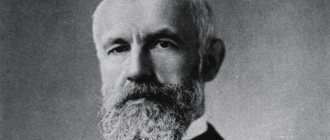Beginning the study of gender psychology
Actually, gender psychology dates back to the 70s. XX century. Its formation was influenced by many factors, including the feminist movement. However, there is still no single concept among scientists regarding this area of science. Also, the history of gender psychology is presented by specialists in completely different ways, which often leads to confusion rather than to clarification of the issue.
The main problem lies in the very interpretation of the term “gender”. Some understand it as purely feminist psychology. The second is simply female. And still others define gender studies as the science of psychological differences between the sexes.
The other side of the issue is that a complex of gender studies began to be simultaneously carried out in different sciences by people from different specialties. Therefore, when studying sexual psychology itself and its history, it is impossible to ignore a number of philosophers, sociologists, ethnographers, as well as public figures.
Traditional family and gender roles
Most modern families adhere to the traditional model, in which the man provides financial support for the family and the woman raises the children. This family model leads to social isolation of women, the impossibility of normal self-realization, discrimination, and the creation of preconditions for domestic violence.
Modern psychologists believe that the traditional family model is outdated and will soon be transformed into a more relevant one. They represent different family models, in which the responsibilities of the “breadwinner” and “housewife” are divided equally, become interchangeable, and are completely eliminated. This will make it possible to more effectively distribute the personal time of husband and wife, allowing them to realize their potential as professionals and parents.
Stages in the history of gender psychology
Most often, the psychology of gender differences is divided into five successive time stages. In general they look like this:
1. Study of problems relevant to the field of gender psychology by philosophers. The beginning of this period goes back to antiquity, and the end falls on the 19th century. As you can see, this is the longest stage, which has a fairly extensive internal periodization.
2. From the end of the 19th century to the beginning of the 20th century, the designation of the subject and the general formation of the main sections of gender studies took place.
3. The third period is associated with Freud, which is why it is also called Freudian. The leading role in it is given to the development of the ideas of psychoanalysis in their connection with the general outline of gender studies. The time thresholds of this stage can be designated as the beginning of the 30s of the 20th century.
4. Next comes the era of practical experiments and, as a result, the accumulation of a theoretical base occurs. This period continues until the 1980s.
5. The fifth and final period, which continues to this day, takes gender research in psychology to a new level. There is an active growth of interested researchers, and the number of experiments is increasing. There is a rapid accumulation of material, which provides a favorable basis for further study of the subject.
The period of the philosophers. Plato
According to generally accepted opinion, gender psychology owes its appearance largely to Plato. Thus, for the first time he focused on the gender problem of sex relations. In a number of his works, Plato develops the doctrine of their complementarity and introduces the term androgyne - a creature that combines male and female characteristics. He is the first to express the idea that the sexes have equal rights in their relationships. Women in Plato's theory of an ideal society can participate with men in all social affairs, as well as be warriors and philosophers. They raise their offspring equally with their husbands.
Gender stereotypes in modern society
Over the long period of people’s existence, normative patterns of behavior and characteristics of a masculine and feminine character have developed and become firmly entrenched in the public consciousness. These are the so-called gender stereotypes, which manifest themselves in all spheres of human life: in interpersonal and intergroup interaction, as well as in the self-awareness of the individual. Being quite stable, they determine:
- Intergender status and dominant roles (man is the breadwinner, woman is the keeper of the hearth; he is smart, she is beautiful).
- Gender traits of personality and behavior (masculine - activity, confidence, dominance, egocentrism, rationality, aggressiveness, etc.; feminine - passivity, dependence, anxiety, emotionality, caring, etc.).
- Ideas about family and professional roles (woman – housewife, mother, performer of labor; man – worker, social activist, organizer, leader).
People living in a certain society compare themselves with its inherent stereotypes. Someone is trying to match these patterns as closely as possible, which is based on the mechanism of obligation. Others prefer to contrast their behavior with accepted norms.
The positive aspects of using stereotypes include the fact that they make it easier to classify people and standardize their behavior patterns. But, in fact, unconscious adherence to gender stereotyping leads to negative results:
- limits the self-realization and self-expression of the individual (especially the female gender);
- acts as a barrier to the development of individuality;
- ignores personal interests;
- creates dependence and obedience;
- worsens quality of life.
We can conclude that independence from such prejudices of society gives the individual the opportunity to gain freedom, spiritual health and the ability to live a full life.
Thomas More
Now let's fast forward to the Renaissance, when thought, “mothballed” by Christian dogmatism for centuries, began to awaken to free life. For example, the theory of Thomas More, described by him in the Golden Book, is interesting. His image of the ideal state assumes that men and women work equally on all matters, without division of labor into “female” and “male” areas. This includes, but is not limited to, religious activities, military service, and senior government positions.
After More, gender relations were considered from one angle or another by such thinkers as Tommaso Campanella and Jean-Jacques Rousseau, Immanuel Kant and many other brilliant thinkers.
Limitations of the male role model
The male model includes a number of restrictions aimed at forming a personality that combines qualities that are opposite to themes that society defines as feminine. A man is expected to:
- provide for family;
- restrain emotions;
- strive for leadership.
In a patriarchal society, a man takes an active social role, and a woman a passive one. While receiving economic and social advantages, he is at the same time forced to constantly assert his status, consciously refusing to display soft character traits. This leads to the development of various personality disorders, suppression of empathy, and the inability to create meaningful relationships.
Second phase
Following philosophical reflection, the period of development that gender psychology went through is characterized by the birth and flourishing of the movement for the liberation of women in society. This is equally true for the USA, England and France. To some extent, this movement also affected the Russian Empire. This process itself, of course, had little correlation with scientific research, and therefore is not part of the history of gender psychology as a science. However, it served as the backdrop and catalyst through which gender studies attracted the attention of many scholars.
Limitations of a female role model
The traditional feminine model dictates that women:
- suppress negative emotions, cultivate empathy, humility, and the desire to meet expectations;
- realize yourself through the role of wife and mother, take on the responsibility of raising children;
- express oneself through the body, trying to fit oneself into accepted standards of beauty.
The gender framework forces women into the careerist mother paradigm. In society, a woman is often perceived only in the role of mother and housewife, and the desire to create a career or combine both roles receives a negative reaction, even to the point of denial of identity.
Scientific works
Scientific works also appeared at this time. For example, at the end of the 19th century, two books by P. E. Astafiev were published, dedicated to the psychology of the sexes and the psychology of women.
Around the same time, the Austrian researcher Otto Weininger published his work Sex and Character. In many ways, this book turned out to be significant, and the problems raised in it, as well as the controversy surrounding them, are still relevant today.
At the same time, Germany, France and a number of other European countries are launching a broad scientific study of female psychology. This period gives birth to a galaxy of outstanding researchers among both men and women: T. Higginson, H. Marion, E. Kay and others.
Third (Freudian) stage
As already mentioned, at the third stage of its formation, gender psychology was inextricably linked with the name of Sigmund Freud. He was distinguished by his views, discussions around which continue to this day. Among researchers of the female psyche, few people could cause as much negative criticism as the father of psychoanalysis. Of course, he was not exactly a researcher specifically in this area. But nevertheless, some of his thoughts, doctrines and works affected gender characteristics in psychology. They were reflected, for example, in the book “Psychology of Women”.
Controversy with Freud
Even many of his students entered into disputes with the father of psychoanalysis. His thesis about a woman’s subconscious complex, which consists of envy of male genitalia, prompted many people to create psychological theories regarding the sexes and their relationships. Therefore, one way or another, Freud had a huge positive influence on the development of gender studies. Although, we repeat, his own beliefs in this area are considered more than dubious.
It ended with the fact that in the middle of the 20th century, psychoanalysis was recognized as a dangerous doctrine for women’s psychological well-being.
However, even now the school of psychoanalysis represents a classic direction in the field of studying the psychology of representatives of the fair half of humanity.
Main directions of gender theory
Psychological support of education. The school, as the main institution of socialization in general and gender socialization in particular, plays a significant role both in the education and in maintaining the existing system of gender stereotypes. This role is usually described by the concept of the “hidden curriculum.” The hidden curriculum includes, firstly, the organization of the educational institution itself, gender relations in the workplace and the gender stratification of the teaching profession; secondly, the content of subjects and educational materials; thirdly, the teaching style. It is the concept of a hidden curriculum that shows that the work of a psychologist with gender stereotypes in high school must be built on an integrated basis with the involvement of all participants in the educational process: teachers, students and parents.
Help for victims of violence. The lack of a gender approach in this area has a particularly negative impact on the effectiveness of educational activities. Violence is seen as part of a patriarchal culture, an extreme form of male dominance and aggression that is welcomed in a culture built on traditional gender roles. Patriarchal gender attitudes lead to distorted perceptions of situations of violence, including the perception of oneself as a victim and the belief that women are “to blame” for what is happening. It is no coincidence that one of the main areas of psychological assistance to victims of violence is working with feelings of guilt, which often turns out to be central in the structure of post-traumatic experiences.
Family counseling. The classic problems here are the so-called role conflict of a working woman and a form of oppression of a man (a man’s value is determined by his level of income and his ability to fulfill the role of “breadwinner” and “breadwinner”).
Raising children - there is an acute shortage of psychologically based literature written from the perspective of ideas of gender equality. family strategies for raising children form a rigid system of gender stereotypes. In these conditions, the task of writing gender-sensitive textbooks on family education and psychology remains very relevant.
Counseling in the field of sexual relations. The mechanism of such difficulties can very often be explained by the fact that gender stereotypes suppress more subtle mechanisms of interpersonal perception and prevent partners from seeing each other as unique individuals, and not as objects of manipulation. Counseling people with a so-called “homosexual identity” whose sexual behavior does not fit into the canons of traditional heterosexuality should also be considered within this area of psychological assistance. The first approach views everything as a pathology of desire, while the gender approach represents the pluralism and variability of sexuality and sexual behavior.
Another traditional practical application of psychological science is interethnic relations, including problems of migration and displacement.
The gender approach can be successfully applied in other branches of practical psychology: in political psychology (here it is especially relevant to work with women politicians who are influenced by sexism and the phenomenon of the so-called “glass ceiling”); in the psychology of sports (the existing system of gender stereotypes forms, among other things, ideas about “male” and “female” sports and often does not allow athletes to realize their potential; in the psychology of advertising and the media.
Third stage in Russia
In our country, after the revolution, the tone of research in the field of gender differences has changed somewhat. With the advent of Soviet power, gender equality was legislated. Initially, they tried to tear women away from the family in order to attract them to production and work, but then the government launched a reverse process. It would seem that these were the best conditions for the development of objective views on gender issues. But in practice, all this led to the denial of gender difference. Soviet science, in principle, did not recognize gender psychology and pedagogy.
Although, for the sake of fairness, it is worth saying that in the USSR there were some scientists who did not agree with this position. They tried to advance the field of gender studies. Among them are the outstanding scientists P. P. Blonsky and E. P. Arkin. But by the 1930s, their work was banned; accordingly, the publication of their works ceased, and all research in this area in the vastness of the Soviet Union was frozen until the collapse of the country.
Research break
Note that there is some gap between the third and fourth periods. It is quite difficult to understand its reason. But it is most likely that the development of feminism was to blame. If earlier, at the second stage, it played a positive role, initiating a vigorous study of gender psychology, then in this case it slowed it down. How? The fact is that in Western society strict social control was established over research related to gender issues. The development of feminism this time received criticism from broad sections of the public, which created difficulties for scientists to study objectively. The scientific world of the West, which studies gender relations, could be seriously shaken if it allowed itself to interfere in this social conflict.
Among the research authors of this time, we can recall the following names of outstanding scientists (and women): E. Maccoby, S. Bem and K. Gilligan.
The result of the period for the West was the accumulation of colossal theoretical material, the emergence of many hypotheses about certain aspects of gender issues.
As for Russia, the first glimmers of light that marked the resumption of scientific research in the field of gender psychology broke through the clouds of ideology in the 60s. People like G. Ananyev made this possible. During this difficult time of confrontation, he became the founder of an entire school of psychology, named after the St. Petersburg or Leningrad school (after the city where the researcher lived).
Also of considerable importance for the history of gender psychology in Russia are the names of V. P. Bagrunov, E. S. Chugunova and others.
Your psychologist. The work of a psychologist at school.
| Psychology of gender differences. Psychology of love |
| Psychological basis for choosing a partner. Marital compatibility |
| Marital disharmony. Psychology of divorce |
| Remarriage. Social and psychological assistance to families |
| All pages |
Page 3 of 6
VI. Psychology of gender differences
1. The category of gender in psychology. Formation of psychological gender In psychology, gender is a socio-biological characteristic with the help of which people define the concepts of “man” and “woman”. Social psychologists believe that the two main reasons people try to conform to gender expectations are normative and informational pressures. Gender is constantly influenced by both cultural norms that dictate what men should do and what women should do, and social messages that tell people how different there is between men and women. Already at 3 years old, children confidently identify themselves as male or female, which is called gender identification. Gender impersonation explains why women tend to enjoy shopping and preparing for the holidays, while men often avoid it. As the child grows, he sees that it is the woman who does such things, and if the child is a girl, then she will be much more interested in this than if there were a boy in her place. We must not forget that gender role socialization is a process that continues throughout human life, it reflects changing circumstances and new experiences. Throughout life, the material for constructing gender is the entire system of what is associated with masculinity and femininity in a given culture: teachers, other children, parents of other children, relatives; - toys; — books in the content of which gender stereotyping can be traced; — television and other media. 2. Gender differences between men and women There are some psychological differences between the sexes: the ability to navigate in space, speech skills and aggressiveness. The ability to navigate in space is successfully demonstrated in most men, which is associated with a higher level of the hormone testosterone in the blood. The centers of speech activity in most women are larger than in men, which has been confirmed by neurophysiological studies. Aggression is inherent in representatives of both sexes, but manifests itself in different ways. Women more often resort to verbal (verbal) aggression, men use physical force. Psychologists began studying gender differences in the late 19th century, but it wasn't until the 1970s. they were mostly engaged in demonstrating the differences between the sexes and justifying the different treatment of men and women. It must be remembered that the differences found are relatively small, usually no more than 10%, and in most cases the distribution of male and female samples is 90% the same. Let's take an example of one of the main differences - emotionality. Research shows that men are no worse than women at identifying the feelings of others and internally empathizing with them, but they are interested in ensuring that others do not notice this in their behavior. Men don't want others to see them as empathetic because it doesn't fit their gender role. Men often find themselves in situations that require them to demonstrate strength, independence, authority, and a desire to compete - qualities that are unlikely to be combined with empathic responsiveness. Toughness is considered one of the most important descriptive characteristics of a “real man.” Adult women express more feelings directed at others (showing interest in the feelings of others, their needs, desires). Men, on the contrary, show more egocentric feelings (needs, desires, self-interests). Women are more comfortable expressing feelings of fear and sadness, yet people do not see gender differences in the ability to experience these feelings. From the above, we can conclude that the emotions and feelings of men and women are the same, but due to their gender roles, they express them differently. 3. Gender Identity and Sex Role Assimilation One of the significant limitations imposed by the traditional female role in our time is that the working woman continues to bear the burden of household chores and responsibility for children. The increase in the proportion of time women devote to work has led to only a slight reduction in their household responsibilities, while the amount of time they spend caring for children has remained unchanged. In work, women are usually of lower status than men. Women are much less likely to hold positions of control over resources and determination of what goals the firm will pursue and in what way. Another problem for working women is that they work a little more at home than their working husbands, which leads to a gap in rest time. Housewives also have many problems. Most of them cannot satisfy their social needs. In addition, most sociologists agree that a woman who earns money enjoys more power in the home. To date, there is relatively little research on the limitations of the traditional male role. The structure of male role norms: 1. Norm of success (status) - men gain status and respect from others. The following stereotypes are encountered. The social value of a man is determined by the amount of his earnings and success at work. Most men are not able to match her 100%, which is why they have low self-esteem. Compensating for feelings of inadequacy in the professional and economic spheres is called compensatory masculinity. When a man fails to live up to one aspect of the masculine gender role, he exhibits exaggerated masculinity in another area. One such area is hardness. 2. The norm of toughness reflects the expectation from a man of mental, emotional and physical toughness. The norm of physical toughness is the expectation of physical strength and masculinity from a man. The self-esteem of men who are not physically strong, although they feel that others expect this from them, can be seriously reduced. At times, the norm of physical toughness can lead to violence, especially when the social situation suggests that it would be unmanly not to be aggressive, or when a man feels that his masculinity is under threat. The norm of mental toughness contains the expectation that a man will appear competent and knowledgeable. A person trying to live up to this model of overcompetence becomes anxious as soon as he realizes that he doesn’t know something. The biggest problem is that in interpersonal relationships, a man who tries to live up to this norm often humiliates others by refusing to admit to them that he is wrong or to admit that someone knows more than he does. The norm of emotional firmness implies that a man should be emotionally firm: have few feelings and be able to resolve his emotional difficulties without outside help. What makes a man a man impoverishes his relationships with children and other people. 3. The norm of anti-femininity. The expectation that men should avoid stereotypically feminine activities and activities. Some men believe that expressing feelings and self-disclosure belongs exclusively to women. A very important part of a person's functioning as a parent is tenderness, care, emotional constant support, the need to often hug the child and tell him that you love him. Many men find these actions difficult because they are associated with femininity, and as a result, many people grow up not knowing whether their fathers truly loved them or not. There is an assumption that the fear of femininity (femiphobia) stems from the fear of homosexuality and is caused by a social context that usually attributes homosexuality to men with femininity traits.
VII. Psychology of love
1. Love as a psychological phenomenon. Theories of love The passion to love, as E. Fromm notes, is the most significant manifestation of human desires. Modern man in love has the following characteristics: • most people look at love from the position of “how to be loved”, and not “how to love”; • the idea that the problem is in love itself, and not in the ability to love; • the concepts of “being in love” and “the state of love” are confused, resulting in the dominant idea that there is nothing easier than love, while in practice it is completely different. To overcome this state, you need to realize that love is an art (as well as human life in general), that it must be comprehended. First of all, we must understand that love cannot be reduced only to the relationship between opposite sexes, man and woman. Love marks all human activity in all its manifestations (love for work, for the Motherland, pleasures, etc.); moreover, love can be the motivator of this activity, its stimulus, a source of energy. Love is often confused with the experience of “falling in love,” the sudden collapse of barriers that existed until that moment between two strangers. In addition, attraction to each other, which is facilitated by the deceptive nature of sexual desire, is often mistaken for love. Theory of L. Kasler. He believes that there are three reasons that make one person fall in love with another. A person in love is extremely ambivalent towards the object of his love. He simultaneously experiences positive feelings towards him, for example, gratitude as a source of vital benefits, and negative ones - he hates him as someone who has power over him and can stop reinforcement at any time. A truly free person, according to L. Kasler, is a person who does not experience love. A. Maslow's theory. The love of a mentally healthy person is characterized, according to A. Maslow, primarily by the relief of anxiety, a feeling of complete security and psychological comfort. Satisfaction with the psychological and sexual aspects of relationships among couple members does not decrease over the years, but increases. Partners experience a constant and growing interest in each other, interest in each other's affairs, etc. They know each other very well, in their relationship there are practically no elements of distortion of perception characteristic of romantic love. They manage to combine a sober assessment of another, awareness of his shortcomings with complete acceptance of him for who he is, which is the main factor providing psychological comfort. It is interesting that, although sex plays a big role in the relationships of the couples examined by A. Maslow, they easily experience frustration of sexual need. The relationships of these people are truly equal; they have no division into male and female roles, no double standards or other prejudices. They remain faithful to each other, which is manifested both in everyday life, for example, in the absence of adultery, and in times of difficulty. 2. Types of love The depth of love and its diversity of types are determined by the refinement of the very ability to love, the development of the human qualities of the lover. In each era, different types and aspects of love were identified, attempts were made to systematize the forms of its manifestation, arranging them in order of significance and meaning. Thus, various terms were used to express different aspects and shades of love in Ancient Greece. The word “eros” denoted feelings directed towards an object with the goal of completely absorbing it into oneself. This term expresses love-passion, jealousy and sensual attraction and is associated with its pathos, affective, sensitive side. The word “philia” (“love-friendship”) means spiritual, open love, based on inner sympathy, expresses the combination of similar principles (while eros is the struggle and union of opposite ones). The word “storge” means love, which is associated with organic family ties, indestructible, not amenable to cancellation (especially family ties). This is tender, confident, reliable love that is established between parents and children, husband and wife. In such love a person finds peace and trust, a feeling of confidence. The term “agape” among the Greeks meant reasonable love, arising on the basis of an assessment of any particularity of the beloved, his character traits, etc.; a person can rationally justify this love, because it is based on beliefs, and not on spontaneous feelings and habits. This is will guided by reason. E. Fromm identifies: • Brotherly love, which is the most fundamental type, forming the basis of all other types of love. It is based on the feeling that we are all one and that existing differences do not count. • Mother's love. This is an unconditional statement of the child’s life and his needs. Because of its altruistic nature, it is considered the highest form of love. • Erotic love. In contrast to the above, striving for complete fusion with a loved one, and this also has a preference. • Self-love, which should be distinguished from selfishness, since an egoist does not love himself, but hates himself. By caring excessively only about himself, the egoist, in reality, makes unsuccessful attempts to compensate for his failure to care for others. • Love for God. R. Sternberg (1987) in his concept considers three basic components of love (passion, intimacy and devotion), on the basis of which possible individual styles of love relationships are determined: love-passion, love-friendship and love-commitment. At the same time, perfect love is considered ideal - a combination of all three components. 3. Structure and content of love experiences The question of the internal structure or components of love was resolved at different levels. And here one of the first and most cited structures is the structure proposed by E. Fromm. He identifies the following components of love: care, responsibility, respect and knowledge. R. Hattiss (1987) identified six factors as components of love: respect, positive feelings towards a partner, erotic feelings, the need for a positive attitude from a partner, a feeling of closeness and intimacy, a feeling of hostility. The presence of negative feelings in the syndrome of love experiences, although contrary to the romantic canon, seems quite natural. Love relationships are extremely significant for their participants; they imply close contact between people and their mutual dependence (at least at the everyday level). In this situation, the object of love cannot help but cause negative feelings, such as irritation, from time to time. Many people, as psychocorrectional practice shows, refuse to accept the natural nature of the periodic occurrence of negative experiences and either justify them, attributing to their partner negative manifestations that are not even characteristic of him, and, as a result, re-evaluate both the partner and their relationship with him, or displace these feelings, which naturally also has destructive consequences for the relationship in a couple. We should dwell on one more structure, which was proposed by Z. Rubin (1987). He identified affection, care and intimacy (trust) in love. 4. Genesis and development of love Many authors saw the basis of the ability to love in the development of man as a herd creature, whose survival was possible only in cooperation with his own kind. The results of scientific research indicate the role of the early period of a person’s life (from birth to 3 years) in the formation of the ability to love. Both positive and negative emotional states, such as fear, can act as prerequisites for love. The love between Romeo and Juliet, which represents one of the models of love relationships recognized in European culture, unfolds against the backdrop of mortal danger caused by the enmity of the Montagues and the Capulets. Identification of the role of the moment of self-interpretation in the genesis of the feeling of love makes the closeness of different types of love between themselves and their mutual conditionality, noted by many authors, more understandable. A.S. Makarenko (1957) noted that the ability to love stems from the experience of positive relationships with parents and comrades. Apparently, this commonality is due to the fact that, although the objects of love change throughout life, the principle itself - explaining to yourself your state as love, and not as, say, selfish interest - remains unchanged. If a person learned such an interpretation in childhood, he will use it in other life situations. A. Maslow notes an important feature of sustainable long-term love. Long-term and close communication does not give a person the opportunity not to see the negative qualities of a partner - according to ordinary logic, which deduces love and sympathy from the presence of extraordinary merits in the object, this makes love impossible. The ability to accept others, characteristic of mentally healthy people, allows them to maintain a feeling of love, despite the awareness of each other’s objective imperfections. There are certain patterns in the development of feelings. Passionate love, no matter how ardent it is, inevitably fades away in the end. The longer the relationship, the fewer emotional ups and downs. 5. Personal predisposition to strong and deep love experiences The study of men and women who first fell in love and then fell out of love gave the following results: - men are more amorous, expressive and sometimes, on the basis of this, commit rash acts; - men are slower to come out of the state of love, unlike women, less inclined to break off relationships when it comes to marriage; - women in love are emotionally involved in love relationships more strongly than their partners, and they are more likely to say that they feel euphoria, pleasant dizziness and carelessness, that they feel like they are “floating in the clouds”; — women tend to focus on the intimate trust of relationships and the need to take care of their partner; — for women, love passes faster than for men, they more often initiate a breakup and experience it more easily; — during the period of established love relationships, women are prone to greater self-disclosure about their feelings (which, by the way, are more in line with the romantic canon than in men). The tendency to experience feelings of love is associated with such traits as: - level of romanticism; - high self-esteem is combined with high-intensity romantic behavior in men and with low-intensity romantic behavior in women; - a high level of self-acceptance provides the opportunity to love another person. — the determining factors for successful long-term love relationships are such characteristics of the individual as the level of mental health, self-acceptance, and competence.
<< Previous — Next >>
Fifth period
The current latest stage in the history of gender psychology, which has been going on for a quarter of a century, is characterized by a greater scope of research than ever before, the breadth of experiments conducted and the development of the gender research movement. New theories are emerging and methods are being developed to study problems of gender relations.
On the other hand, the detailing of research led to the fact that within gender psychology not only separate schools, but also new directions and sections of science began to emerge. Some of them have gone quite far from each other in their theoretical views and practical principles.
Among the countless names and works of this stage, we note the brilliant book by Megan Byrne - “Gender Psychology”.
As for the Russian world of science, unfortunately, years of stagnation led to the absence of a base on which it was possible to build a competitive research school. In our country, gender psychology is just beginning to develop, which does not deprive us of the prospect of taking a leading position in the future. A prerequisite for this is the fact that Western researchers, along with tremendous experience, have also accumulated a significant number of unresolved problems and contradictions. The weakness of these schools is that they focus on particulars, while theories that would allow one to generalize the entire experience of gender research and create a holistic view of the nature of this phenomenon are still very poorly developed. This prospect is opening up to Russian researchers today.
Among the latest achievements of our compatriots, we can note such important works as “Gender Psychology” (I.S. Kletsina) and “Gender Socialization” (A.V. Kuramshev).
How do such relationships manifest themselves in marriage?
The most striking example of masculine and feminine relationships at the interpersonal level are marital relationships, which can be found in two key models:
- Affiliate. Represents equality of family members, respect for the individual, taking into account the principles and interests of spouses. Main features:
- communication is built on trust, mutual respect, empathy;
- the authority of both spouses;
- flexible division of duties;
- family roles are interchangeable;
- the desire to find a compromise in possible conflicts;
- absence of encroachment on the individuality of the chosen one;
- discussing problems and failures on a confidential level, without reproaches, with support;
- taking into account the rights and wishes of children, accepting their opinions;
- the family is perceived as an island based on love, security, peace, and confidence in the future.
- Dominant-dependent. Represents the dominance of one spouse and the subordination of the other. At the same time, the dominant demonstrates independence, composure, authority, confidence, and self-worth. Key Features:
- ignoring the interests and opinions of the dependent spouse and exclusively accepting the decisions of the power partner;
- division of power based on force;
- clear division of family responsibilities;
- conflicts are usually resolved in a destructive way;
- condemnation and ridicule of problems, failures, mistakes;
- total control;
- isolation of the family from society;
- authoritarian parenting of children, built on the principles of hypercontrol and submission;
- family is perceived as an unwanted debt obligation based on feelings of loneliness, anxiety, and insecurity.
In modern industrial society, gender relations in the family presuppose the presence of two main roles:
- Expressive – given to the spouse. It consists of maintaining a comfortable climate in the house.
- Instrumental – corresponds to the spouse. It consists of providing financial support for the family.
Often these roles are interchangeable and, as a rule, correspond to a partnership model of relationships.









